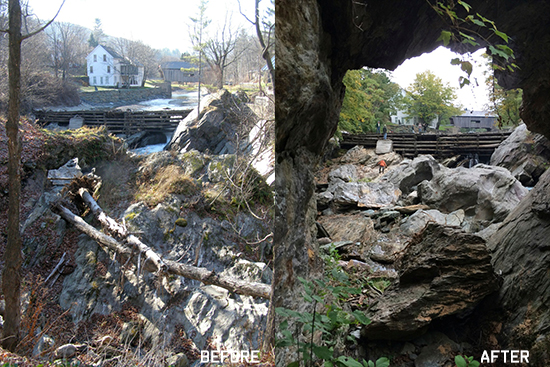
By Rachel Goff
What might be best for the environment might not always be best for a town.
Earlier this month, members of the Warren Village Dam Preservation Trust sat down with Deb Markowitz, secretary of the Vermont Agency of Natural Resources (ANR), to discuss the likelihood of obtaining a permit to repair the town's 200-year-old timber crib dam.
Once an integral part of a bustling mill town, the wooden structure has started to deteriorate. In 2009 and again in 2012, the trust applied for stream alteration permits to repair the dam, but the ANR deemed those applications incomplete until the trust submitted more information.
According to Ellen Strauss of the Warren Village Dam Preservation Trust, the information the state requested "were all really expensive scientific studies," she said, "and we have no money."
But now, under the new leadership of David Sellers, "We wanted to see if there's some other way we can do it," Strauss said. And so the trust set up a meeting with the state.
Coming out of the meeting, it seems "the ANR doesn't really want to compromise on anything" when it comes to issuing a permit to repair the dam, Strauss said, "although this time they said they would meet with our engineer."
In general, the ANR wants to see structures that were previously installed in waterways throughout Vermont either removed or left to deteriorate, so that rivers are allowed to return to their natural states.
In agreeing to meet with the trust's engineer, however, the state has "left the door open a little bit" for repairing the dam, said Warren Energy Committee co-chair Eric Brattstrom, who also attended the meeting with Markowitz, "and we're going to go for it," he said.
"We don't have an engineer yet," Strauss said, but the trust has already started looking for one.
"That's the only real way of hope for the trust," said Warren Select Board member Matt Groom, who also attended the meeting with Markowitz. "They need to find an engineer who understands timber crib dams and can speak to the intricacies of them," Groom said, and that engineer "has to be credible enough and informed enough to perform a study and then convince the ANR to change their mind."
According to Groom, Markowitz was "distinctly pessimistic" about the likelihood of the trust being able to obtain a permit to repair the dam, explaining that the dam was in such bad shape that it would need to be replaced rather than repaired. "That puts us in a different category for permitting," Groom said, as replacements are subject to an even higher level scrutiny from the state.
"I want to see the dam stay there," Groom said, but "I'm trying to realistic. ... I've just come to the point where I'm starting to hear from anyone who has any decision-making power that it's not going to happen."
Indeed, "It's a pretty complicated situation," Strauss acknowledged. "I don't know if you can say that we're total dreamers and that we'll never get anywhere," she said of her and the trust's efforts to repair the dam. "But I think the conversation is worth having."
Since the Warren Village Preservation Trust owns the dam, "We don't have any actual power to do anything about it," Groom said, speaking for the town, "other than starting a dialog."
In previous public forums that the select board has held regarding the future of the timber crib dam, residents have spoken out in support of repairing the structure, which is an iconic image of the town and holds emotional ties for many of its residents. "It would break my heart to see it go," one woman said at a forum last October.
In addition to being a historically significant structure, the timber crib dam is also "a resource for the village," Strauss said, explaining that if the trust were to repair the dam, they would want to take advantage of its hydroelectric potential.
Unfortunately, "Hydro, like wind, is suddenly a dirty word in Vermont," Strauss said, speaking to the public's opposition to the renewable resource for fear of its negative environmental impacts. But many of those fears are unfounded, Strauss said, and "If the ANR wanted to use this dam as a demonstration of how to successfully do a microhydro project ... I think we could do it," she said.
"My sense is to wait and see what we could do," Strauss said. But time is limited.
"What we're suggesting to the trust is that if they're going to do something, they need to do it without further delay," Groom said, explaining that the dam, in its current condition, is dangerous. "There are sinkholes," he said.
When Groom asked the ANR about patching up holes in the dam to make it safer, they replied "very definitely" that the trust would also need to obtain a permit for those repairs, he said. The only suggestion the state had for improving the safety of the river was installing signs or ropes surrounding the dam, "But that, to me, is a pretty naïve response," Groom said. "It's like trying to rope off a football field. It's a pretty large area."
Taking into consideration the state's most recent response, the Warren Village Dam Preservation Trust will discuss its plans for repairing the dam with the select board at a meeting this January (date to be announced) and members of the public are encouraged to attend.
{loadnavigation}






